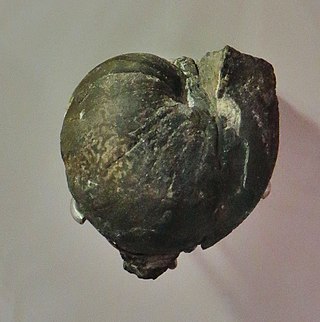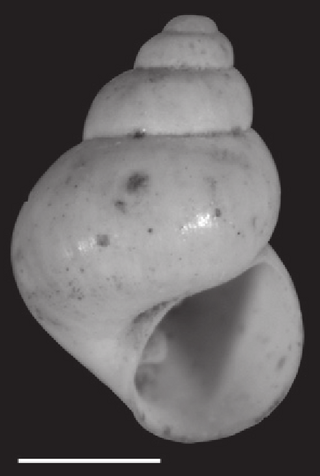
Clymenia is a genus in the ammonoid order Clymeniida, restricted to the Upper Devonian, characterized as with all clymeniids by a dorsal siphuncle that runs along the inside of the whorls, unusual for ammonoids.
Sholakoceras is an extinct genus of nautiloid cephalopods from the Lower Permian of southern Russia, included in the Tainoceratacean family Rhiphaeoceratidae,. The shell of Shalakoceras is evolute with a perforate umbilicus. Whorl sections are subquadrate with the ventral and lateral sides flattened and ventral and umbilical shoulders rounded. Lateral areas bear short, slightly oblique ribs. sutures form broad ventral saddles with a slight, shallow lobe, very shallow lateral lobes, and a deep funnel-shaped dorsal lobe.
Endolobus is an extinct genus from the nautiloid order, Nautilida. Nautiloids are a subclass of shelled cephalopods that were once diverse and numerous but are now represented by only a handful of species, including Nautilus. Endolubus is included in the family Koninckioceratidae which is part of the superfamily Tainoceratoidea.
Valhallites is an extinct genus in the nautiloid order Nautilida which includes the living Nautilus found in the tropical western Pacific Ocean. Valhalites belongs to the Koninckioceratidae, a family in the Tainoceratoidea, a nautilid superfamily.

The Trigonoceratoidea are a superfamily within the Nautilida that ranged from the Devonian to the Triassic, thought to have contained the source for the Nautilaceae in which Nautilus is found.
Syringonautilidae is a family of Nautiloidea from the middle to late Triassic. Syringonautilidae comprise the last of the Trigonoceratoidea and are the source for the Nautilaceae which continued the Nautiloidea through the Mesozoic and into the Cenozoic right down to the recent. Syringonautilidae is a strictly Triassic family, derived early in the Triassic from the Grypoceratidae.

Grypoceratidae is the longest-lived family of the Trigonoceratoidea, or of the near equivalent Centroceratina; members of the Nautilida from the Upper Paleozoic and Triassic.
The Trigonoceratidae is a family of coiled nautiloid cephalopods that lived during the period from the Early Carboniferous (Mississippian) to the Early Permian.
The Centroceratidae is the ancestral family of the Trigonoceratoidea and of the equivalent Centroceratina; extinct shelled cephalopods belonging to the order Nautilida
The Naedyceras group comprises three similar and closely related openly coiled, gyroconic, genera within oncocerid family, Brevicoceratidae: Naedyceras, Gonionaedyceras, and Gyronaedyceras.
Aphelaeceras is an extinct genus from the nautilid family Trigonoceratidae which is part of the Trigonocerataceae, that lived during the Mississippian Period in the late Paleozoic.
Condraoceras is a genus of liroceratids from the Pennsylvanian of North America and Lower Permian of Europe with a compressed, involute, nautiliconic shell; subcircular whorl section; small umbilicus with a rounded shoulder; suture with shallow ventral and lateral lobes; and narrow subcentral siphuncle.

Peripetoceras is a genus in the Clydonautilacean family, Liroceratidae. It can be recognized by its smooth, involute shell with a deep small umbilicus with rounded shoulders and steep convex wall; whorl section with flattened venter, rounded ventral shoulders and convergent slightly convex flanks; suture with slight ventral and lateral lobes; and small siphuncle located dorsally of the center.
Holconautilus is a genus of nautiloids from the family Tainoceratidae and order Nautilida, named by Mojsisovics, 1902, and known from Upper Triassic sediments in Europe and E Indies (Timor). Its shell, evolute, discoidal, with simple coarse lateral ribbing; whorl section, subrectagular with a broadly arched venter.
The Rhiphaeoceratidae are a small family of nautilids included in the superfamily Tainoceratoidea that comprises four very similar genera. These genera are characterized by a perforate umbilicus and little more than a single evolute coil. Whorl sections are oval, subquadrate, or subtrapezoidal. Sutures bend forward on the outer rim, forming wide shallow ventral saddles and dip strongly to the rear on the inner rim, forming deep dorsal lobes.
Pseudonautilidae is a family of Jurassic and Lower Cretaceous nautilid cephalopods belonging to the same superfamily as modern Nautilus, Nautilaceae, but forming a different branch from the family Nautilidae. Pseudonautilids, together with other nautilids, were contemporary with the ammonoids, which comprise an entirely different set of shelled cephalopod stocks more closely related to octopus and squid.

Marstonia comalensis is a species of minute freshwater snail with a gill and an operculum, an aquatic gastropod mollusk or micromollusk in the family Hydrobiidae. It is found in south central Texas, United States.
The Tetragonoceratidae is a small family of nautilitids constituting a part of the superfamily Tainocerataceae in which shells are coiled with a generally quadrate whorl section. Coiling is either gyroconic or evoluute with a slight dorsal impression. Flanks diverge from the umbilical to the ventral shoulders so as to make the whorl sections widest close to the venter. Nodes made develop on the flanks and shoulders. The siphuncle is tubular, typically found near the venter. Sutures are with lateral lobes and may possess dorsal and ventral lobes as well.
Cymatonautilus is a genus of cymatoceratids from the middle and upper Jurassic of Europe, the Middle East and Asia characterized by a robust shell with a wide umbilicus and subquadrate whorl section, slightly wider than high. The flanks and venter are flattened. The flanks have a wide lateral groove; the venter a more narrow median groove. The suture has a shallow ventral lobe and broad concave lateral lobes, crossed obliquely by sinuous ribs that produce a deep ventral sinus. The siphuncle is subcentral.

Domatoceras is a nautiloid genus and member of the Grypoceratidae from the Pennsylvanian and Permian with a wide spread distribution.



